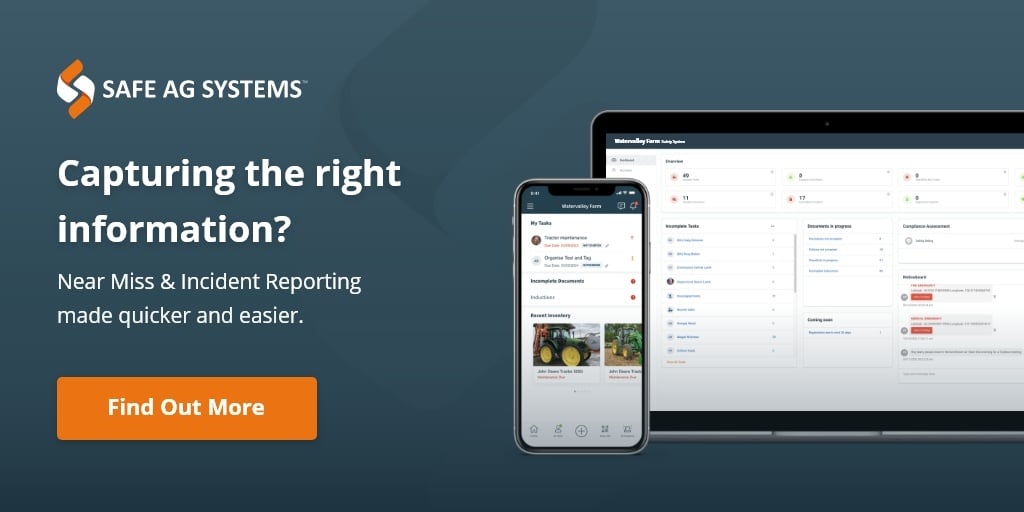MYTH: If I start to record incidents and near misses, that will just open me up to fines or expose me to litigation
We are quite passionate about dispelling this myth. In fact, you may be more vulnerable to fines or litigation if you ignore or try to hide an incident or near miss.
What if your incident or near miss could save your life - would you learn from it? Now think if your experience could save someone else’s life. Would you want them to know about it?
What is the difference between a near miss and an incident in farming?
What is a near miss: An unplanned event happening, that does not result in an injury/illness or damage but had potential to do so. This could include bystanders and pedestrians getting too close to moving machinery or using an auger with an unguarded PTO. A near miss identifies a fault in your processes, management system or working environment, providing you with an opportunity to make improvements. Other common terms you may have heard; “a close call” or “narrow escape”.
What is an incident: Any unplanned event resulting in injury, ill health, damage or loss. Unfortunately, in farming we hear of this all too often in regard to machinery including tractors – an overturned tractor had the potential to result in harm to the operator.
What is a hazard: Anything with the potential to cause harm to a person, property, or equipment. The key difference between a Hazard and a Near Miss is potential for something to occur, and something unplanned occurring for a Near Miss.
Why is it important to report a Near Miss?
If you are familiar with WHS laws, you will understand the importance of having a system in place that captures near miss reporting. If you have an incident or near miss but decide not to report it, not only are you neglecting to improve safety in your workplace, it could get you into trouble if the regulator decides to investigate or if an insurance claim is made. Near miss and incident reporting is essential for gathering insights and improving faming business operations before they cause a serious problem.
Utilising a proactive method and creating a positive culture around near-miss reporting has its business advantages. Not only are you promoting a safe working environment, you are mitigating risks, encouraging timely reporting, educating workers, identifying hazards and negative trends, and your team are actively preventing further accidents and injuries from occurring.
Are there benefits to reporting a near miss or incident for farming businesses?
When reporting near misses and incidents, use it as an opportunity to find solutions. Utilise your learnings for injury prevention - reduce future risks - promote safety culture in your workplace with awareness. And let your workers how they can assist with risk management and avoid any serious incidents from happening.
A good reporting and communication process will help you to address hazards in real-time. It is also a positive reinforcement that you are committed to the health and safety of your workers and expect them to take it seriously (as you do). A healthy near-miss reporting culture on your farm can:
-
enable farming businesses to pro-actively resolve hazards before a tragic or costly incident occurs
-
engage all workers in solving problems
-
increases safety ownership and reinforces workers' self-esteem
-
expose valuable information that otherwise might not be discussed
-
develop a positive and necessary attitude surrounding safety
-
demonstrate compliance with part of the WHS laws
-
most likely save you time and money by preventing serious incidents
-
help in your defense if the regulator wants to investigate a serious incident or fatality
A good near-miss and incident report provides workers with a systematic approach in order to complete the report. A well planned report template also supports management in collecting data by reducing the opportunity for human error. Every report is a chance to gain further insight into your business with the aim to identify and control hazards, reduce risk and prevent harmful incident.
There are a number of high level benefits - with the biggest being continuous improvements for your health and safety program. As a performance measurement - every action is capturing data ready to be analyzed. Near-miss reporting promotes an open culture where workers are comfortable to participate, share and contribute to positive changes. When analysed correctly, your report can assist in identifying trends and statistics - your high traffic zones might need a traffic plan.
Let’s plan for success in farm safety
There are numerous components that make up a successful Near Miss and Incident reporting culture. What are some simple steps to help you plan for success in your farm business?
-
Create health and safety policies and procedures to communicate your required standards
-
Promote a culture of reporting - communicate that near miss reporting is a non-punitive system
-
Educate workers on the reason why near miss reporting is necessary
-
Ensure that the near miss reporting process is easy to complete
-
Include training for workers, especially during inductions
-
Celebrate the wins! Report on positive actions taken to improve safety in the workplace
Topics: Safety Management System
Disclaimer: Content on this website may be of relevance to users outside of Australia, but content links and examples are specific to Australia. Please check with your local authority for your country and industry requirements.











